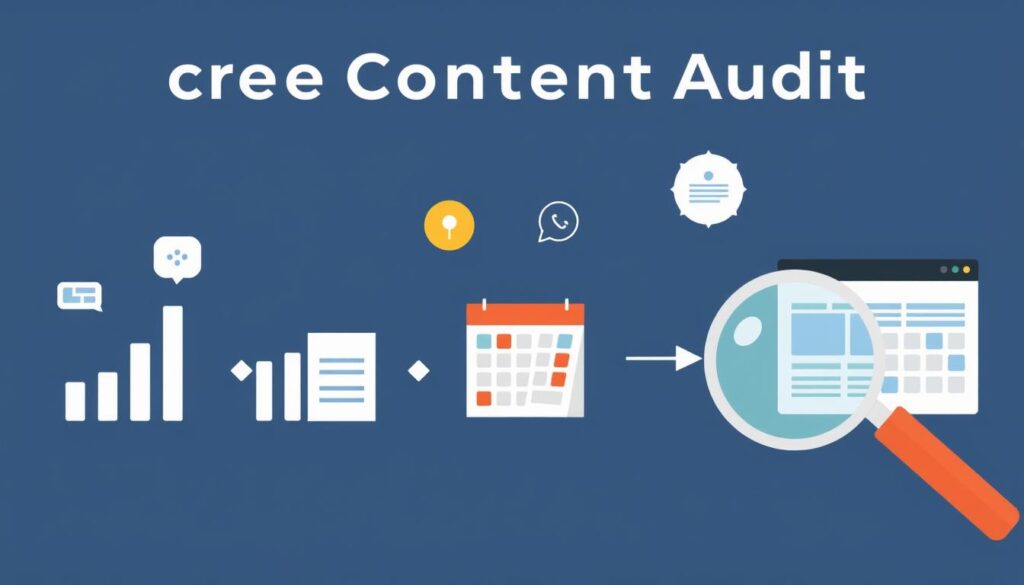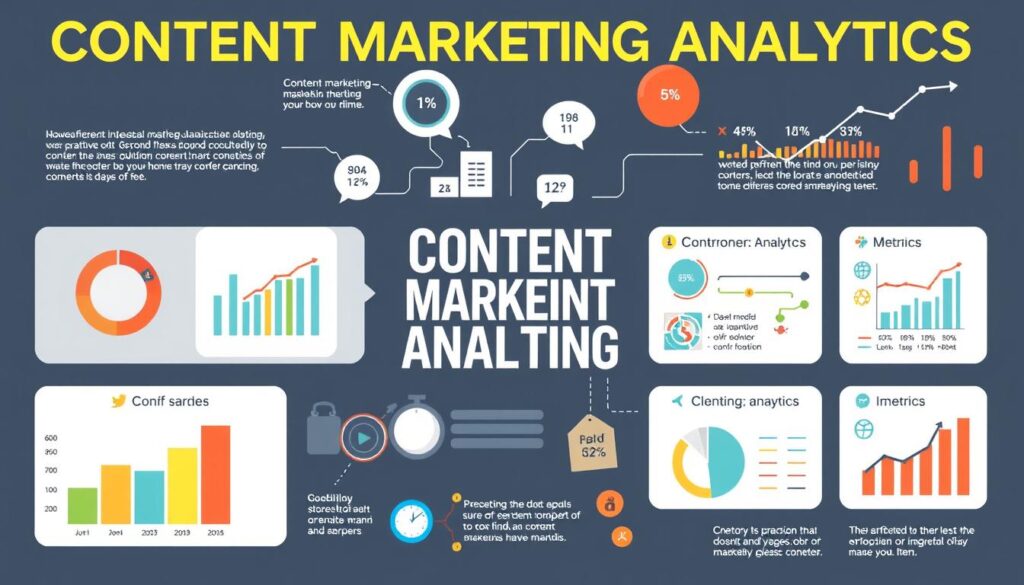In today’s digital landscape, a well-crafted content strategy is crucial for businesses to maximize their marketing impact.
We will explore how a comprehensive content strategy serves as the foundation for all content marketing efforts and helps align various marketing initiatives to drive measurable results.
Understanding your audience and creating content that resonates with them is vital.
A successful marketing strategy requires regular assessment and refinement to achieve goals.
Key Takeaways
- Understand the importance of a comprehensive content strategy.
- Learn how to align content marketing efforts with business goals.
- Discover the key components of an effective content strategy.
- Understand the importance of knowing your target audience.
- Recognize the need for regular assessment and refinement.
What is Content Strategy Development?
Content strategy development is a systematic approach that businesses use to plan, create, and manage content effectively. It involves a comprehensive process that aligns content creation with business objectives, ensuring that all content produced supports the overall strategy of the organization.
Definition and Core Components
A content strategy is the planning, creation, publication, management, and governance of content. It is designed to attract and engage a target audience, meeting their needs while driving business goals. The core components of a content strategy include audience analysis, content planning, creation processes, distribution channels, and performance measurement.
- Audience analysis to understand the target audience’s needs and preferences.
- Content planning to ensure alignment with business objectives.
- Creation processes that are efficient and effective.
- Distribution channels that reach the target audience.
- Performance measurement to assess the success of the content.

How Content Strategy Differs from Content Marketing
While content marketing is often used interchangeably with content strategy, they serve different purposes. Content strategy is the planning and governance of content, providing a blueprint that guides all content marketing activities. Content marketing, on the other hand, is the tactical execution of the strategy, focusing on the creation and distribution of content to attract and engage audiences.
In essence, a well-developed content strategy is foundational to successful content marketing, ensuring consistency in messaging, voice, and brand identity across all content touchpoints.
Why Your Business Needs a Strong Content Strategy
To maximize impact, businesses need to develop a content strategy that resonates with their target audience. A well-planned strategy ensures that all marketing efforts are aligned with business goals, enhancing overall performance.
When content creators, social media managers, writers, and other team members are aligned on goals such as brand awareness, lead generation, or customer engagement, they can produce content that consistently supports these aims. This increases the chances of getting tangible results.
Aligning Teams on Goals and Objectives
A strong content marketing strategy aligns different teams within an organization around common goals and objectives, creating cohesion in marketing efforts. By doing so, it ensures that everyone is working towards the same outcomes, such as increased brand visibility or improved customer engagement.
This alignment is crucial for maximizing the effectiveness of our content. When all teams are on the same page, we can create a unified message that resonates across various channels and touchpoints.
Guiding Content Creation and Distribution
A content strategy provides clear direction for content creation, ensuring that every piece of content serves a specific purpose in the customer journey. It involves planning the type of content to create, such as blog posts, infographics, videos, and podcasts, as well as determining the most effective channels for distribution.
By having a clear plan, we can ensure that our content is not only engaging but also relevant to our audience’s needs at different stages of their journey.

Optimizing Resources and ROI
A well-defined strategy helps businesses optimize their resources by focusing efforts on content that delivers the highest return on investment. By analyzing performance data and adjusting our content plan accordingly, we can ensure that our marketing efforts are as efficient as possible.
This approach enables us to allocate our resources more effectively, reducing waste and improving overall ROI. By doing so, we can achieve better outcomes from our content marketing strategy.
Key Content Strategy Statistics for 2024
As we dive into 2024, it’s crucial to examine the latest statistics shaping content strategy development. The data provides valuable insights into how businesses are approaching content marketing and what strategies are proving most effective.
Investment Trends in Content Marketing
The investment in content marketing continues to grow, with more than 90% of marketers either maintaining or increasing their investment in 2025, as per the HubSpot State of Marketing Report, 2025. This trend underscores the importance of content strategy in overall marketing strategy. The table below highlights some key investment trends:
| Trend | Percentage |
|---|---|
| Marketers increasing investment in content marketing | 90% |
| Marketers using voice search optimization | 13% |
| Marketers finding it challenging to generate traffic and leads | 15% |
Performance Metrics and Benchmarks
Understanding performance metrics is crucial for evaluating the success of content marketing efforts. For instance, 17% of marketers report that short-form videos have generated strong results for their businesses, according to the HubSpot Marketing Trends Report, 2024. Additionally, 90% of social media marketers emphasize the importance of building an active online community for a successful social media strategy.
Essential Elements of an Effective Content Strategy Plan
To maximize impact, businesses need to develop a comprehensive content strategy plan. This plan serves as a roadmap for creating and distributing valuable, relevant, and consistent content to attract and retain a clearly defined audience.
An effective content strategy plan encompasses several key elements. Let’s explore these essential components in detail.
Clear Goals and Objectives
Establishing clear goals and objectives is the foundation of a successful content strategy. These goals should align with your broader business objectives, ensuring that your content efforts contribute to the overall success of your organization. For instance, your content goals might include increasing brand awareness, generating leads, or driving sales.
Audience Personas and Target Market
Understanding your target audience is crucial for creating content that resonates with them. Developing detailed buyer personas helps you gain insights into your ideal customers’ needs, preferences, and behaviors. To create accurate audience personas, you’ll need to conduct research through surveys, interviews, and analysis of your social media engagement.
Content Audit and Gap Analysis
Conducting a thorough content audit is essential for assessing your existing content’s performance and identifying gaps in your content ecosystem. This process involves evaluating your current content assets, determining what’s working and what’s not, and identifying opportunities for improvement.
Content Types and Distribution Channels
Selecting the right content types and distribution channels is vital for reaching your target audience effectively. You need to consider the various content formats available, such as blog posts, videos, podcasts, and social media posts, and choose the ones that best align with your audience’s preferences and your business objectives.
Some key considerations for an effective content strategy plan include:
- Establishing content creation processes and workflows that ensure consistency and quality
- Implementing content governance to maintain brand standards and ensure compliance with industry regulations
- Developing a measurement framework to track content performance and demonstrate ROI to stakeholders
By incorporating these essential elements into your content strategy plan, you can create a robust content marketing strategy that drives business growth and achieves your marketing goals.
Step 1: Define Your Content Goals and Objectives
Defining content goals and objectives is the foundational step in developing a comprehensive content marketing strategy. To create an effective content strategy, you need to establish clear goals that align with your business objectives. This involves understanding what you want to achieve through your content and how it supports your overall business aims.
Aligning Content Goals with Business Objectives
Your content goals should be closely tied to your business goals. This means examining your high-level business objectives, reviewing notes from meetings and team discussions, and conducting solo research to ensure your goals have staying power. By aligning your content goals with your business objectives, you can create a focused content strategy that drives meaningful results.
For instance, if your business goal is to increase brand awareness, your content goal might be to boost website traffic by 20% within the next quarter. If your business objective is to generate more leads, your content goal could be to increase the number of newsletter subscribers by 50% within six months.
Using the SMART Framework for Goal Setting
To make your content goals actionable, it’s helpful to use the SMART framework. SMART stands for Specific, Measurable, Achievable, Relevant, and Time-bound. By applying this framework, you can transform broad goals into clear, actionable objectives.
For example, instead of saying “we want more website traffic,” a SMART goal would be “we aim to increase organic website traffic by 15% within the next 90 days by publishing two SEO-optimized blog posts per week.” This goal is specific, measurable, achievable based on current resources, relevant to the business objective of increasing brand awareness, and time-bound.
| SMART Criteria | Example Goal |
|---|---|
| Specific | Increase organic website traffic |
| Measurable | By 15% |
| Achievable | Through publishing two SEO-optimized blog posts per week |
| Relevant | Aligns with increasing brand awareness |
| Time-bound | Within the next 90 days |
“Setting goals is the first step in turning the invisible into the visible.”
By defining clear content goals and objectives using the SMART framework, you can create a content strategy that is focused, effective, and aligned with your business goals.
Step 2: Conduct Comprehensive Audience Research
The final output is enclosed in the “ tag as required.
Step 3: Perform a Content Audit

To refine your content strategy, it’s essential to conduct a thorough content audit. This process involves evaluating your existing content to understand its performance and effectiveness. By doing so, you can identify what’s working and what areas need improvement.
Evaluating Existing Content Performance
When evaluating your existing content, consider metrics such as traffic, engagement, conversions, and SEO performance. Tools like Google Analytics and social media analytics can provide valuable insights into how your content is performing. Look for patterns in what types of content perform best and use this information to inform your future content marketing efforts.
Identifying Content Gaps and Opportunities
A content audit also helps you identify gaps in your content and opportunities for new content creation. By mapping your existing content to your buyer personas and journey stages, you can reveal areas where you need more content. Additionally, analyzing your competitors’ content can help you identify topics and formats that could fill gaps in your own content strategy.
By conducting a thorough content audit, you can make informed decisions about your content, ensuring that it aligns with your overall marketing goals and objectives. This process is crucial for optimizing your content and improving its overall performance.
Step 4: Choose the Right Content Management System

A well-chosen content management system can significantly enhance the execution of your content marketing strategy. A CMS is the backbone of your content operations, enabling you to create, manage, and publish content efficiently.
When selecting a CMS, there are several key features to consider. These include content creation tools, workflow management, publishing capabilities, and analytics integration. The right CMS should streamline your content processes and improve collaboration among team members.
Key Features to Look for in a CMS
The ideal CMS should offer robust content creation and editing tools, allowing your team to produce high-quality content. Workflow management features are also crucial, as they enable you to assign tasks, track progress, and ensure that content is reviewed and approved efficiently.
Additionally, consider a CMS with flexible publishing capabilities and seamless integration with analytics tools to measure content performance.
Popular CMS Options for Different Business Needs
Different businesses have different CMS needs. For instance, enterprise-level organizations might benefit from comprehensive solutions like Adobe Experience Manager, while smaller businesses might prefer open-source platforms like WordPress.
For businesses requiring more flexibility, headless CMS options are worth considering. Ultimately, the choice of CMS depends on your specific content needs, team size, technical capabilities, and budget constraints.
It’s also important to consider the scalability and flexibility of the CMS to accommodate evolving content strategy needs. By choosing the right CMS, you can ensure that your content strategy is executed effectively and efficiently.
Step 5: Determine Your Content Mix and Formats
The key to an effective content strategy lies in selecting the right mix of content formats. A well-crafted content mix not only engages your target audience but also aligns with your business goals and available resources. To achieve this, we need to consider various factors, including audience preferences, marketing funnel stages, and the role of evergreen versus timely content.
Content Types for Different Marketing Funnel Stages
Different content types serve distinct purposes throughout the marketing funnel. For instance, awareness-building blog posts and social media content are ideal for attracting top-of-the-funnel consumers who are still exploring their needs. As these leads progress through the funnel, case studies and product demos become more relevant, helping to convert them into customers.
To effectively cater to consumers at various stages, consider the following content types:
- Blog posts and social media content for awareness
- E-books and whitepapers for consideration
- Case studies and product demos for decision-making
- Email newsletters for retention
By understanding thebuyer’s journeyand mapping content to each stage, we can create a more targeted and effective content strategy.
Balancing Evergreen and Timely Content
Striking a balance between evergreen content and timely content is crucial for maintaining a dynamic content strategy. Evergreen content provides long-term value, remaining relevant over time, while timely content addresses current trends and topics, keeping your audience engaged with fresh information.
A balanced approach might involve:
- Creating a foundation of evergreen content that attracts consistent traffic
- Supplementing with timely content to capitalize on trends and seasonal interests
- Repurposing evergreen content into new formats to keep it relevant
This balance ensures that our content remains both relevant and engaging, supporting our overallcontent creationefforts.
By carefully determining our content mix and formats, we can develop a content strategy that not only resonates with our audience but also drives meaningful marketing results.
Step 6: Develop Your Content Creation Workflow
To ensure timely and quality content delivery, establishing a robust content creation workflow is essential. This process involves several key steps that help streamline content production, from idea generation to publication.
Assigning Roles and Responsibilities
Assigning clear roles and responsibilities to team members or freelancers is critical for efficient content creation. This includes strategists, creators, editors, and distributors, each playing a vital role in the content lifecycle. By defining these roles based on team size and capabilities, you can ensure that each piece of content is handled by the right person, enhancing overall quality and productivity.
Creating an Editorial Calendar
Developing an editorial calendar is a crucial step in planning and scheduling content in advance. This calendar helps align content production with strategic priorities and marketing campaigns, ensuring that your content remains consistent and relevant. When creating an editorial calendar, consider using templates that can be tailored to your specific needs, making it easier to manage and adjust your content schedule as needed.
Establishing Content Governance Guidelines
Content governance involves setting standards and policies for content creation, publication, and maintenance. This includes developing content style guidelines, tone of voice documentation, and content quality criteria to ensure consistency and quality over time. By establishing these guidelines, you can maintain a cohesive brand voice and ensure that all content meets your quality standards.
By implementing these strategies, you can develop an efficient content creation workflow that ensures consistent quality and timely delivery of content assets. This not only enhances your content strategy but also supports your overall business objectives.
Step 7: Implement Measurement and Analytics

Implementing a robust measurement and analytics framework is crucial for evaluating the success of your content marketing strategy. By establishing clear metrics and key performance indicators (KPIs), you can assess the effectiveness of your content efforts and make data-driven decisions to optimize your approach.
To measure the success of your content, you need to define clear metrics for each goal. For instance, if your goal is to increase brand awareness, you may track engagement rates such as likes, shares, and comments. On the other hand, if your goal is lead generation, you may focus on conversion rates and the number of leads generated through your content.
Key Performance Indicators for Content Strategy
The KPIs you choose should align with your content goals. Common KPIs include awareness metrics like reach and impressions, as well as conversion metrics like lead generation and sales. By tracking these KPIs, you can gain insights into how your content is performing across different channels and stages of the customer journey.
For example, if you’re using content to drive sales, you may track metrics such as conversion rates, sales revenue, and customer acquisition costs. By analyzing these metrics, you can refine your content strategy to better support your business objectives.
Tools for Tracking Content Performance
There are various tools available to help you track content performance, including web analytics platforms like Google Analytics and specialized content analytics solutions. You can also use native social media analytics tools to monitor engagement and other metrics on social media platforms.
Additionally, platforms like HubSpot’s analytics platform provide a unified overview of your content distribution efforts across multiple channels, including social media, emails, and PPC advertisements. By leveraging these tools, you can gain a comprehensive understanding of your content’s performance and make informed decisions to optimize your strategy.
Real-World Content Strategy Examples
By analyzing successful content strategies from various industries, we can identify key elements that contribute to their effectiveness. Let’s explore some real-world examples that demonstrate the power of a well-crafted content strategy.
B2B Content Strategy Success Stories
In the B2B space, companies like HubSpot and Salesforce have developed effective content strategies that drive engagement and conversions. For instance, HubSpot’s comprehensive blog and educational resources establish the company as a thought leader in the marketing and sales software industry.
- HubSpot’s use of in-depth guides and webinars to educate their audience.
- Salesforce’s Trailblazer community, which fosters engagement and loyalty among its customers.
These B2B companies demonstrate how a content marketing strategy can be tailored to the specific needs and pain points of their target audience, ultimately driving business growth.
B2C Content Strategy Success Stories
In the B2C space, brands like Nike and Airbnb have created content strategies that resonate with their audiences and inspire action. For example, Nike’s storytelling focuses on empowering athletes and promoting an active lifestyle, while Airbnb’s content highlights unique travel experiences.
- Nike’s use of compelling narratives and user-generated content to build brand loyalty.
- Airbnb’s travel guides and community stories that inspire wanderlust and drive bookings.
These examples illustrate how a successful content strategy can be applied in different business contexts to achieve marketing goals and build a strong brand identity.
Bringing It All Together: Your Content Strategy Roadmap
As we conclude our comprehensive guide on content strategy development, it’s time to bring all the pieces together. Developing a robust content strategy is a multifaceted process that requires careful planning and execution. In this final section, we’ll provide a comprehensive roadmap for developing and implementing a content marketing strategy that drives real results for your business.
To start, we’ll outline a phased approach to content strategy development that businesses of any size can adapt to their specific needs and resources. This involves prioritizing content strategy initiatives based on potential impact, resource requirements, and alignment with business goals. By doing so, you can ensure that your content efforts are focused on the most critical areas.
Gaining organizational buy-in for your content strategy is crucial. This can be achieved by demonstrating its connection to business outcomes and ROI. To maintain momentum and consistency in your content strategy implementation over the long term, it’s essential to establish clear goals and objectives, as well as a well-defined plan for achieving them.
Common pitfalls and challenges in content strategy development include failing to align content with business goals, inadequate resource allocation, and insufficient measurement and analysis. To overcome these challenges, it’s vital to regularly review and refine your content strategy as business goals, audience needs, and market conditions evolve.
By following this roadmap and staying committed to your content strategy, you can drive meaningful engagement, conversion, and revenue for your business. As a final step, we encourage you to take the insights and recommendations from this guide and begin developing or enhancing your content marketing strategy immediately.






